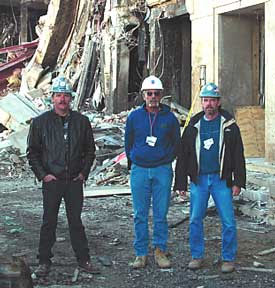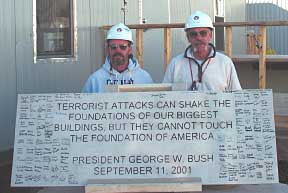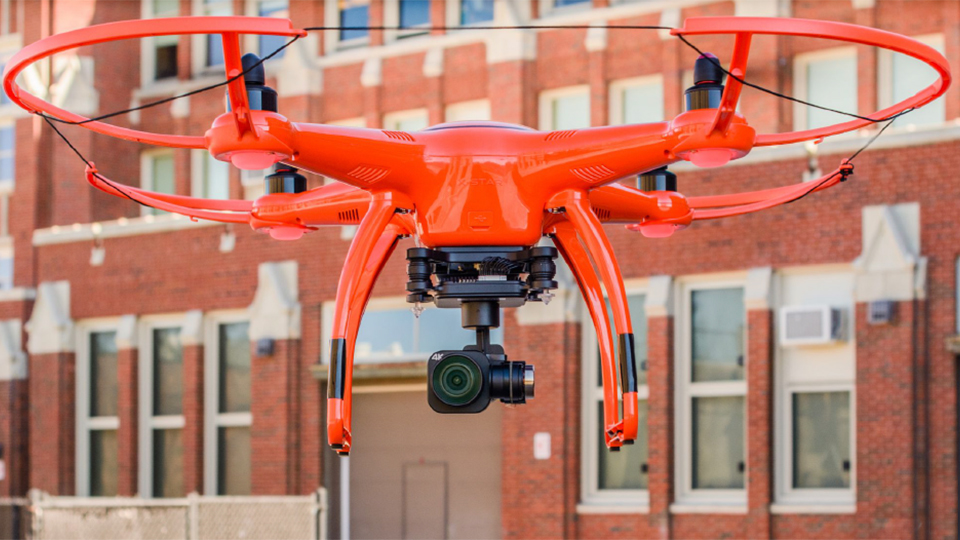The Human Side: The Phoenix Team
By Tom Inglesby
 The three Masonry Arts musketeers were reunited on September 15. From the left, Joe Windsor, Rich Bartram, and Ric Vignevic. |
Joe Windsor is a general foreman with Masonry Arts, Bessemer, Ala. On September 11, 2001 he was working on the renovation of Wedge 1 at the Pentagon. He and Ric Vignevic, another foreman, were the last two Masonry Arts employees on the site as their part of the job was ready for turnover to the government. At 8 a.m., they went to Home Depot for some last minute material.
Windsor recalls. "On the way back, we were stuck in traffic when we saw a fireball from the vicinity of the Pentagon. Moments before, my wife had called me on the cell phone and told me about the World Trade Center being hit by an airliner."
"It took about an hour and a half before we were able to get off I-395," adds Vignevic. "Then we worked our way back to The Union Hall in Maryland. None of our cell phones worked, they must have shut down the system. By the time we called home from the hall, our wives were in a panic, not having heard from us for hours and knowing the plane had hit the section where we were supposed to be working. To this day, my wife won't watch the news because of that."
Vignevic and Windsor made their way back to the Pentagon to see what they could do to help. "We didn't think we'd be able to get back in but we did," Windsor says. "For the next 30 days, we were on the job here doing whatever we could ? welding this, burning that, carrying and moving and helping. Every day, 10 or 12 hours a day, we'd be here. We knew those walls; we'd literally built them. We knew our expertise would help in bringing them down, so we helped with the demolition."
Masonry Arts was only one of many companies with crews at the site when the plane hit. When you work construction, you get to know the other trades, the other workers. "When we were working with the cleanup crew, every time remains were found and brought out, they'd blow a horn and we'd all stop out of respect," remembers Windsor. "You'd stand there with a lump in your throat, wondering who was in that body bag. One day, one of the other tradesmen near me started crying and it hit me hard. It wasn't as personal until you saw somebody who had lost a buddy that day."
 Vignevic points to the building, nearing completion, and says, "The trades are the ones getting this done. We all bought into this. We were all here before this happened, the contract was almost over, and all of them left. Now they're all back. This job is only getting done because of the subcontractors. The lower echelon here all bought into this and that's why we're dedicating the hours. Right from the start, we all said, 'This is going to be done, this is going to happen.' Now I can see the results; it is happening."
Vignevic points to the building, nearing completion, and says, "The trades are the ones getting this done. We all bought into this. We were all here before this happened, the contract was almost over, and all of them left. Now they're all back. This job is only getting done because of the subcontractors. The lower echelon here all bought into this and that's why we're dedicating the hours. Right from the start, we all said, 'This is going to be done, this is going to happen.' Now I can see the results; it is happening."
Isaac Peterson is a stonemason from Alabama. A young man, Peterson has been with Masonry Arts for nine years. He came to the Pentagon after September 11 and was involved in the clean up of the removed limestone. "I was asked if I wanted to come up and work on the Pentagon and I jumped at the chance," he exclaims. "When I got here, all I could see was a big hole in the wall with burned and blackened limestone around it. It seems like everybody started pitching in right when it happened. I thought it was my way to be able to be part of it. We started right away taking down the facade, stone by stone, cataloging them, marking them as to where they came from on the building, and moving them to a storage yard for cleaning."
Peterson was involved with the cleaning, testing for integrity, and resetting of the stone. In November, he went back to Alabama. "I asked my girlfriend to marry me. She loves Washington; she'd like to live here. We both agree, it's been an honor to be involved in something that's going to show the world: people can put a hole in our life but we can put it back together quickly and do it right. It's something that I can do for my country that I know how to do."
Across the Potomac River from the Pentagon, in Washington, Christopher Fromboluti's office at Hellmuth, Obata & Kassabaum overlooks the building. Fromboluti is a principal with HOK, the architectural firm for the Pentagon Renovation Program (PenRen) starting in 1994. They did the Wedge 1 architecture and he's personally been involved since then. "I saw the sky filled with smoke that morning, in the direction of the Pentagon. Then, when I found out what had happened, I was filled with anger. Two weeks later, the feeling turned to honor as I found out I would be on the team designated to rebuild the damaged area. The project is very important to me."
 Senior associate Craig Morgan of HOK was working on the plans for the PenRen program that day in September. "When I heard something had hit the Pentagon, the first thing I wished was that none of the people working for me were on the job there. I ran around the office, checking who was in and who was out at the site. We were lucky; nobody from our office was there."
Senior associate Craig Morgan of HOK was working on the plans for the PenRen program that day in September. "When I heard something had hit the Pentagon, the first thing I wished was that none of the people working for me were on the job there. I ran around the office, checking who was in and who was out at the site. We were lucky; nobody from our office was there."
The Phoenix Project is a textbook case of teamwork in action, but that's not always the way these cases end up. Morgan thinks this will be different. "This is a team project. Not mine, not his, not the general contractor's ? it's our team's project. Chris has been responsible for all the technical aspects, and I'm the project manager for HOK. Everyone gets there at 6 in the morning; in the winter, it's still very dark and everyone is cold but we are all there, ready to work. All around you are workers with hard hats and Pentagon jackets with the flag on them; it is more of a team than you'll find in any sport. We'd work under lights ? there were three shifts for a long time at the beginning of The Phoenix Project ? and everyone was enthusiastic. That's what made it special."
Morgan adds, "I've never in 30 years worked on a project where everybody is together. The architect, owner, contractor, subcontractors, workers ? everybody's together. No one is pointing fingers at anybody. If you make a mistake it's because you're going so fast. Everybody covers everybody else and we don't worry about little mistakes, we just fix them and keep going. It's remarkable. I've never seen anything like it. I hope to work on another project like this but never again because of an attack like this."
About the Author
Tom Inglesby is a San Diego-based freelance writer whose work has appeared in numerous online and print publications. He is the winner of the Construction Writers Association's 2002 Boger Award for Special Reports.















